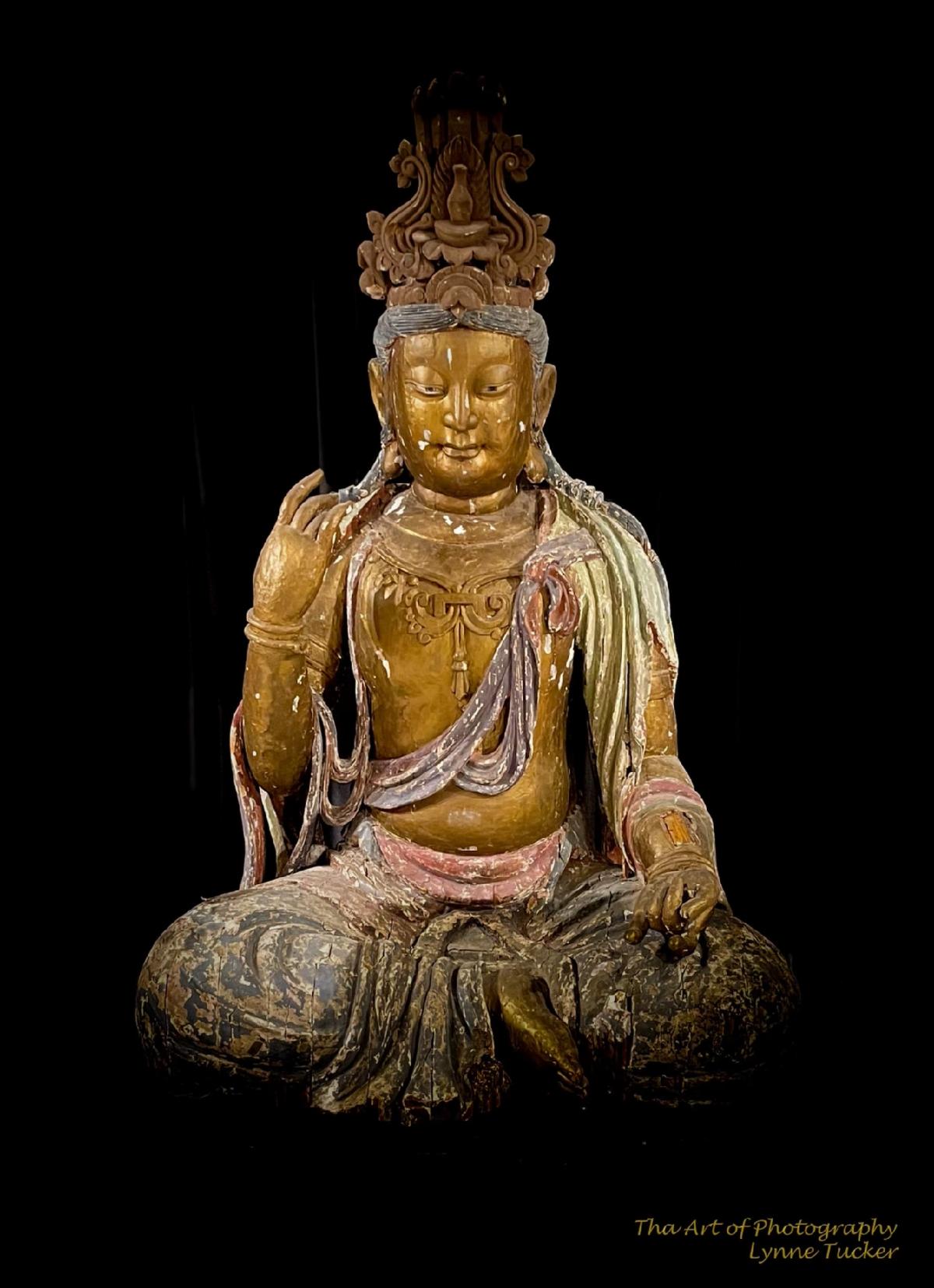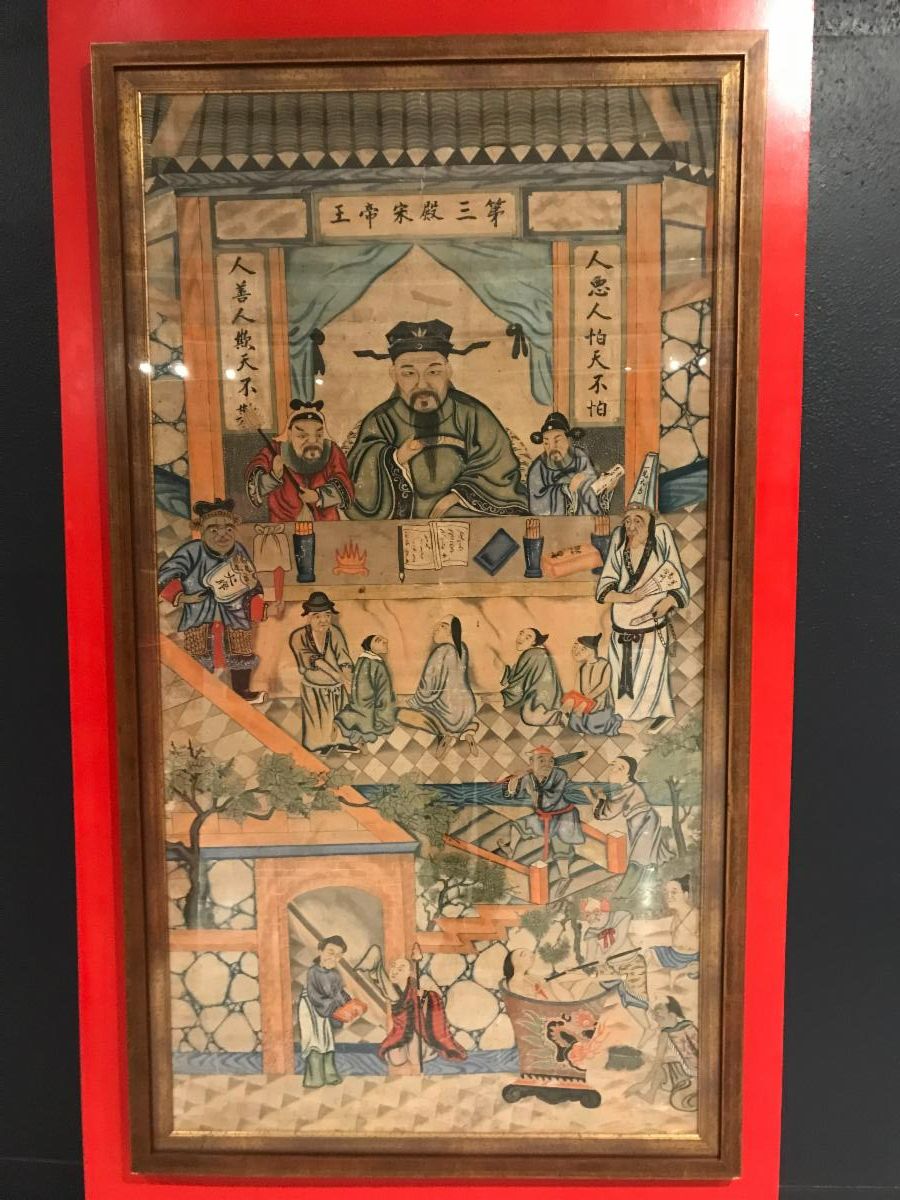|
MoAW presents
Spotlight:
ALL UNDER HEAVEN
Treasures From The East
Earth, Heaven, and the Afterlife
| |
|
This exhibition of 50 authentic antiquities from China, Japan, Indonesia, and Southeast Asia spanning 3,600 years ago to the mid-1800s is made possible through generous gifts from Heather James Fine Art, (Palm Desert), Tim Walsh, Marlene and Bruce Kanter.
All Under Heaven is a phrase used more than 3,000 years ago to express contentment with the dynastic rulers of China. Intimidating Japanese temple guardians flank the entrance to greet you with a diverse collection of artifacts. Ancient objects used by the living, the graceful temple icons, Buddha and Shiva, and figurines from the noble tombs of the ancient deceased of Asia await you.
This substantial acquisition was presented to MoAW at the beginning of 2022 and our staff raced to curate, design, and narrate the collection for public exhibition. With these artifacts gathered together for the first time, MoAW is proud to present ALL UNDER HEAVEN: Treasures of the East; Earth, Heaven, and the Afterlife.
| |
 | |
Figure of Maitreya
China, Ming Dynasty
(1368 - 1644)
Painted Wood
Gift of Heather James Fine Art
Maitreya, the "happy Buddha" of the future represents the harbinger of a new age. He arrives after a period of decline and chaos to restore order and harmony to civilization.
The name Maitreya comes from the Sanskrit word Maitri, which means "loving-kindness."
This Buddha-to-be from China's Ming dynasty sits in vajrasana, the left hand in varadamudra and the right hand in vvitarkamudra, with his feet crossed at the ankles. The position represents reasoning, debate, or instruction.
Assuredly a major sculpture from a Buddhist temple, this figure is seven feet tall, weighs more than 700 pounds, and is approximately 650 years old, according to carbon-14 dating.
Dressed in the clothes of either Bhiksu or Indian royalty and adorned with jewelry and a high tiara, the eyes are made of ancient glass and obsidian.
Maitreya exudes majesty and limitless tolerance and generosity. His image appears for the first time in Gandhara, a historical region (1st millennium B.C.E.) in what is now known as Pakistan, possibly predating images of other Buddhas.
|  | |
OX
Chinese, Han Dynasty
(202 BC - 220 AD)
Stone
Gift of Marlene and Bruce Kanter
From an ancient burial tomb of an elite nobleman, in Chinese culture, oxen are symbols of wealth, prosperity, diligence, and perseverance. All things needed for the afterlife.
|  | |
Four Ladies on Horseback
China, Tang Dynasty (618 - 906)
Terracotta
Gift of Marlene and Bruce Kanter
Burial figurines of graceful dancers, mystical beasts, and everyday objects reveal both how people in early China approached death and how they lived. Since people viewed the afterlife as an extension of worldly life, these figurines, called Mingqi or "spirit goods," disclose details of routine existence and provide insights into belief systems over the millennia.
By the Han dynasty (206 BC-AD 220) taking servants into the tomb with the deceased in the form of human sacrifice ceased. Instead, figures representing the attendants, servants, concubines, and entertainers of the deceased were buried with the corpse to employ in the netherworld.
|  | |
Daoist Folk Judgement Court
China, c. 1925
Ink and pigment on silk
Gift of Heather James Fine Art
Diyu, or earth prison, is the realm of the dead or "hell" in Chinese mythology. It is loosely based on a combination of the Buddhist concept of Naraka, and traditional Chinese beliefs about the afterlife.
Diyu is typically depicted as a subterranean maze with various levels and chambers, to which souls are taken after death to atone for the sins they committed when they were alive. The exact number of levels of Diyu and their associated deities differ between Buddhist and Taoist interpretations. Some speak of three to four "courts"; others mention "Ten Courts of Hell", each of which is ruled by a judge (collectively known as the Ten Yama Kings); other Chinese legends speak of the "Eighteen Levels of Hell". Each court deals with a different aspect of atonement and different punishments; most legends claim that sinners are subjected to gruesome torture until their "deaths", after which they are restored to their original state for the torture to be repeated
|  | |
Bronze Archer
Japan, Meiji Period
(1868 - 1912)
Bronze
Gift of Marlene and Bruce Kanter
In 1868 the restoration of imperial rule in Japan brought the Edo shogunate to an end and marked the start of the Meiji era which would last until the death of Emperor Meiji in 1912. During this period the country experienced radical social and political shifts and a host of reforms that propelled Japan, closed to international trade for more than 200 years, from feudalism into the industrial age of modernity.
The profound impact of the country's new engagement with foreign cultures is evident in many areas of Meiji period art, which reflected a new era for the nation and its developing relationship with the wider world. With the disappearance of the samurai class, metal workers began to create objects for the sole purpose of display The government encouraged innovation and attention to artistry. The fine detail in this work is beyond the capability of their Western counterparts and is hardly matched in present-day Japan. Exhibitions in both Japan and Europe brought Meiji-period metalworkers high praise, and their creations were soon highly sought after by collectors around the world.
|  | |
MoAW's mission is to educate a diverse audience about the history of ancient civilizations and prehistoric life using fossils and artifacts from a variety of cultures and time periods; to enhance universal curriculum development for local and surrounding school districts, colleges, and universities, establishing museum diversity for the Coachella Valley.
Hours of Operation:
Monday - Saturday
10:00 a.m. to 6:00 p.m.
Sunday 12:00 noon to 5:00 p.m.
The last admission is taken one hour before closing.
Admission:
$15.00 Adults
$12.00 Students, Seniors, & Military
$ 3.00 Discount available for Coachella Valley Residents
$10.00 Group Rate for 10 or more individuals.
A 501(c)(3) nonprofit organization, MoAW is a member of the North American Reciprocal Museum (NARM) Association, the American Alliance of Museums, and the California Association of Museums.
MoAW IS SPONSORED BY
| |
Members Perks
The newest perk of membership: Free admission to over 1,200 museums nationwide through the North American Reciprocal Museum Program (NARM) Plus, discounts at their museum shops and restaurants (if given to their members). Local museums include the Palm Springs Art Museum and Cabot's Pueblo Museum, several museums in Los Angeles, San Diego, San Francisco, throughout California, all 50 states, and the District of Columbia, plus Canada, Mexico, and Bermuda. This is available to all members at the Donor Level ($125.00) or higher. Current members who qualify will be receiving new membership cards with the NARM logo to be used at participating museums.
Current members who would like to upgrade their membership to take advantage of this new benefit please give us a call, (442) 268-5004.
Click below for more information and to join.
THANK YOU
| |
On Display In Association With PALEO: The Story of Life
STARSCAPE:
A Journey To The
Beginning of Time
This spectacular collection of 33 space photographs combines breathtaking digitalized images from the historic Mariner, Viking, and Voyager probes with stunning photographs from the Apollo lunar missions, the Hubble Space Telescope, and ground-based observatories. Gathered from the National Aeronautics and Space Administration, The Jet Propulsion Laboratory, the California Institute of Technology, the Royal Observatory, Edinburgh, the Hansen Planetarium, and the Hubble Telescope, this awesome display of cosmic spectacles is a journey to the early days of the cosmos.
|  |
Cathedral City
Historical Society
presents
Then and Now
A 40th-year anniversary exhibition of the history of Cathedral City
A comprehensive photographic and artifact-rich timeline of the history of Cathedral City will greet you upon entering the lobby of the Museum of Ancient Wonders. This is an exhibition of recollections of the people and places that created Cathedral City's early history and to celebrate the 40th anniversary of its burgeoning progress, from the past to the present, THEN AND NOW is a loving tribute to the City of Cathedral City.
|  | |
PALEO: The Story of Life
4.6 billion years of fossil history
Drawn from the world’s foremost fossil collections, the unprecedented treasury of fossil casts known as PALEO: The Story of Life brings together into one exhibition some of the most exciting finds in the history of paleontology from over a century of worldwide excavations, exhibited in geological, chronological order.
From 2.5 billion-year-old single cellular cyanobacteria responsible for the oxygenation of the atmosphere to the first multicellular life of 700 million years ago, PALEO: The Story of Life spans 4.6 billion years in scope. From the Precambrian to the Paleozoic Era, from the Triassic, Jurassic, and Cretaceous Periods of the Mesozoic Era to mammals and prehistoric humans of the Cenozoic Era (including the famous Lucy skeleton), this internationally acclaimed, comprehensive collection dramatically illustrates the awesome story of prehistoric life on Earth.
Displaying casts of rare fossils from the Americas, Europe, Asia, Africa, and Australia, this prestigious collection includes skeletons, skulls, claws, and eggs gathered from such revered museums as the Smithsonian Institution, the American Museum of Natural History, The Royal Ontario Museum, the Carnegie Museum, and the National Museums of Kenya, Ethiopia, and Tanzania, as well as many others.
|  | |
Nio Figure
Japan
(1467 - 1652)
wood
ALL UNDER HEAVEN
Treasures of the East
Earth, Heaven,
and the Afterlife
A Very Special Gift From
Marlene and Bruce Kanter,
Heather James Fine Art
Michael H. Healy
Tianxia (天下) or, All Under Heaven is one of the most ancient Chinese phrases having been used for more than three thousand years, it defines the ideal of a perfect and harmonious empire in the eyes of the people.
50 original antiquities spanning millennia (3,600 B.C. to 1850 A.D.) of ancient Asian Cultures from mysterious funerary objects and life-size protective temple guardians to decorative terracotta sculptures of beasts of burden created for the tombs of the deceased. With a tapestry of silk and gold thread, a rare lacquered cosmetic box and earthen vessels, bronze statues, these ancient treasures from China, Japan, Indonesia, and Southeast Asia, celebrates everlasting happiness, enduring remembrance, and eternal life.
MoAW premieres these dazzling artifacts from the world of Asian antiquity displayed for the first time together in one exhibition All Under Heaven: Earth, Heaven, and the Afterlife.
|  |
LUCY:
The Story of Human Origins
(Courtesy of the Institute of Human Origins and the National Museum of Ethiopia,
Addis Ababa)
On view exclusively at the
Museum of Ancient Wonders
| |
MoAW, Museum of Ancient Wonders
Cathedral Gateway Plaza
69028-B East Palm Canyon Drive
HWY 111 at Date Palm Drive
Cathedral City, CA 92234
(442) 268-5004
moaw.org
MoAW is a 501(c)(3) non-profit organization
| | | | | |